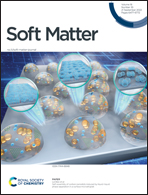Deciphering the origin of the melting profile of unilamellar phosphatidylcholine liposomes by measuring the turbidity of its suspensions†
Abstract
The elucidation of the thermal properties of phosphatidylcholine liposomes is often based on the analysis of the thermal capacity profiles of multilamellar liposomes (MLV), which may qualitatively disagree with those of unilamellar liposomes (LUV). Experiments and interpretation of LUV liposomes is further complicated by aggregation and lamellarization of lipid bilayers in a short time period, which makes it almost impossible to distinguish the signatures of the two types of bilayers. To characterize independently MLV and LUV of 1,2-dipalmitoyl-sn-glycero-3-phosphocholine (DPPC), the latter were prepared with the addition of small amounts of 1,2-dipalmitoyl-sn-glycero-3-phosphatidylglycerol (DPPG) which, due to the sterical hindrance and negative charge at a given pH value, cause LUV repellence and contribute to their stability. Differential scanning calorimetry curves and temperature-dependent UV/Vis spectra of the prepared MLV and LUV were measured. Multivariate analysis of spectrophotometric data determined the phase transition temperatures (pretransition at Tp and the main phase transition at Tm), and based on the changes in turbidities, the thickness of the lipid bilayer in LUV was determined. The obtained data suggested that the curvature change is a key distinguishing factor in MLV and LUV heat capacity profiles. By combining the experimental results and those obtained by MD simulations, the interfacial water layer was characterized and its contribution to the thermal properties of LUV was discussed.



 Please wait while we load your content...
Please wait while we load your content...